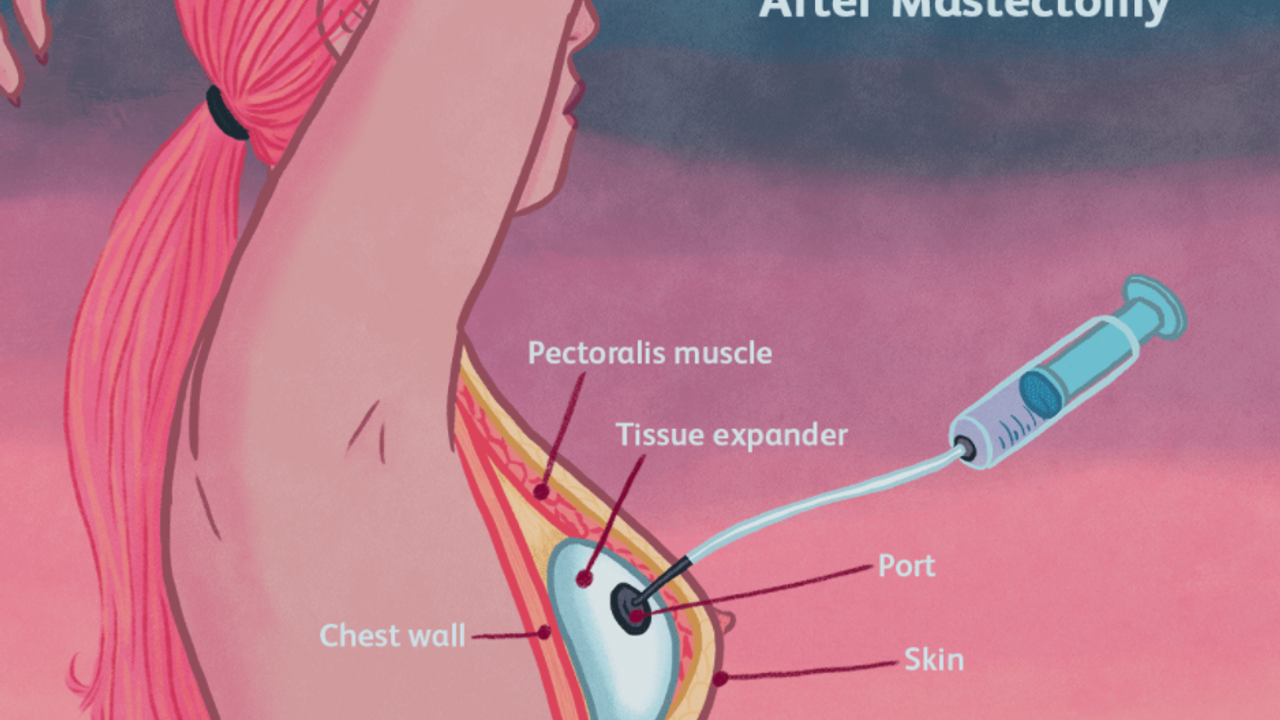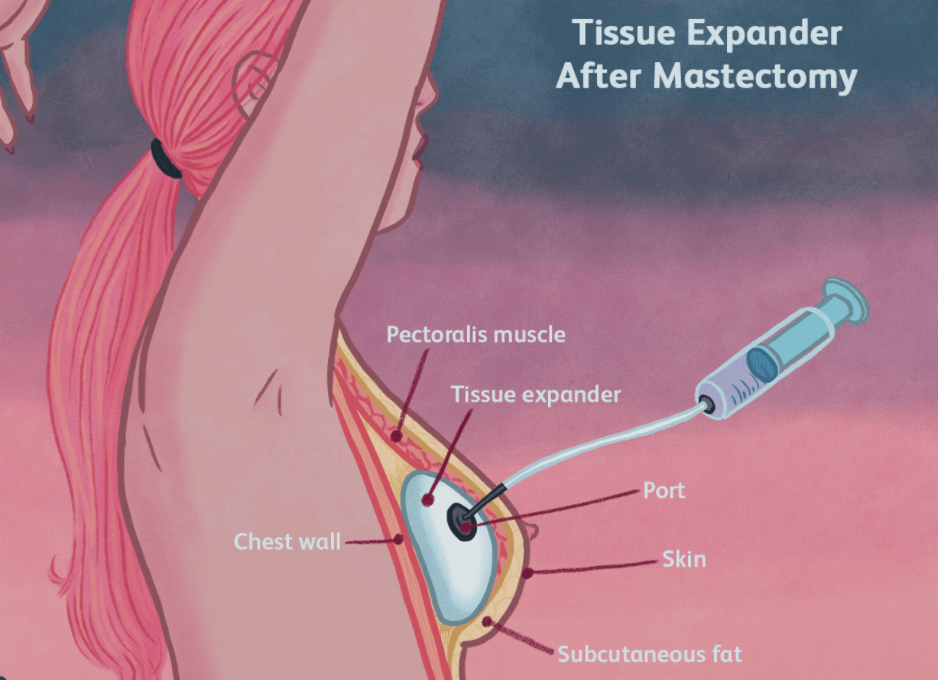
What is the difference between expanders and breast implants?
Sep 09, 2021There are a few critical differences between expanders and implants, and whether you're a patient or a massage therapist, it's important to know what they are used for and why.
First, let's talk about expanders.
These are temporary silicone "pouches" that get filled with saline fluid over a period of months to stretch the skin, muscles and fascia of the chest.
Expanders are used primarily in breast reconstruction during breast cancer surgery, or for breast construction during Transgender breast augmentation, otherwise known as top surgery for Trans women.
For both populations, stretching the soft tissue of the chest area is critical to be able to accommodate the size and shape of the permanent implant that will replace the expanders down the road.
They are usually placed underneath the pectoralis major muscle (aka: pec major), which is known as subpectoral placement.
 (image from: https://www.verywellhealth.com/tissue-expander-pain-causes-and-help-guide-430394)
(image from: https://www.verywellhealth.com/tissue-expander-pain-causes-and-help-guide-430394)
Top uses for expanders:
- Soft tissue expansion - for breast cancer patients who've lost their natural breast tissue and want to recreate their breasts, or for Trans women who want to construct breasts during gender affirming surgery.
Expanders are often extremely tight and frequently painful. Think about taking the skin of your forearm and fitting a lemon underneath it. That would be tight and probably painful, right?!
That's a very rough metaphor for what an expander is like. It's taking an otherwise flat area and making it round. An expander is designed to stretch tight tissues over time, so they will start out smaller and get bigger as more fluid is injected into them (known as a fill).
It is common to get a fill every 2 - 3 weeks at the surgeon's office, for 2 - 6 months, or even up to a year, depending on desired chest size and how easily the tissues stretch.
Top considerations for expanders:
- Temporary in nature, designed to expand in size over time so the soft tissue of the chest can stretch. They are often tight and painful, especially in the beginning.
So what's the difference between expanders and implants?
Expanders are a type of implant, but usually when we speak about implants we are talking about permanent implants. One of the biggest differences between expanders and implants is that one is designed to be temporary, the other is designed to be permanent.
Another major difference is the permanent implant will stay the same size. An expander is designed to change size over time, but a permanent implant will not. What you see is what you get.
An important point to note: expanders always require a secondary surgery because they are designed to be switched out. Permanent implants will often require just the one surgery to put them in.
When are permanent implants used?
- During breast surgery for a permanently larger breast size.
Women wanting to go up in cup size, say from a "B" to a "D" but are keeping all their own breast tissue in the process will get a permanent implant. This is a fairly common surgery, especially in women between the ages of 35 - 50. According to the 2020 Plastic Surgeon Statistics Report, 193,073 women in the USA got breast augmentation surgery. This type of breast augmentation a single surgery and does not require use of expanders.
However, permanent implants may be put in as a secondary surgery after expanders have done their job. This will be used by women undergoing breast reconstruction due to breast cancer, or Transgender women getting breast construction if their feminizing hormones did not grow sufficient breast tissue.

(photo from: https://www.fda.gov/consumers/consumer-updates/what-know-about-breast-implants)
Top considerations for permanent implants:
- They are generally less painful than expanders and, barring complications, may require no more surgery for at least 10 years.
Permanent implants may be circular in shape, flatter on the back side that sits agains the chest wall, and more curved on the front side, that faces out to the world. They used made in a teardrop formation to more closely mimic the natural shape of the breast, though these days they are mostly circular with a smooth outer texture.
A complication that can happen after implants are put in is capsular contracture, where the body grows a fibrous capsule around the implant to protect the body from the foreign object. When capsular contracture gets very advanced, it can grow up around the shoulder to create Adhesive Capsulitis, otherwise known as Frozen Shoulder. If capsular contracture gets very advanced, a secondary surgery to remove the capsule may be necessary.
What can be done to help with comfort levels after expander or implant surgery?
Massage can be a very useful tool to apply after breast surgery.
In my private massage therapy practice, I have seen how it can ease tightness of the breast and chest and help the expanders sit more comfortably in the chest, as well as reduce stress and anxiety, creating a more pleasant, comfortable experience for patients overall.
A 2019 literature review in the International Journal of Bodywork and Massage relayed soft tissue mobilization has been shown to positively impact scar tissue tension, decrease reliance on pain medication and allowed desensitization to pressure.
An early 1999 study by Mary Bredin into the effects of massage on altered body image (ABI) after breast surgery showed massage helped promote acceptance of new body shape through application of healthy caring touch.
A more recent 2018 study by Massingill et.al. showed myofascial techniques are useful for treating chronic pain and mobility limitations following breast surgery.
So whether you are a lay person going through breast surgery yourself and wanting to learn how to massage yourself, or a professional massage therapist, learning how to massage breasts after both expanders and permanent implants is incredibly useful.
We offer programs for both lay-people and professionals to learn breast massage.
If you are a lay-person or patient, you will learn to massage your own breasts in our "Living with a Mastectomy" program, a super cost-effective way to become familiar with your own anatomy, build confidence in caring for yourself as well as diminishing pain and tightness across your breasts and chest.
If you are a healthcare professional, our Level 1 certification course is fully accredited up to 14 PE credits for BC RMTs, and will teach you in depth knowledge about how to care for 18 different types of breast surgery.
Check out our links below to find out more!
References:
Bredin M. Mastectomy, body image and therapeutic massage: a qualitative study of women's experience. J Adv Nurs. 1999 May;29(5):1113-20. doi: 10.1046/j.1365-2648.1999.00989.x. PMID: 10320494.
FDA - Retrieved Aug. 31/21 from https://www.fda.gov/consumers/consumer-updates/what-know-about-breast-implants
Massingill J. et.al. (2018) Myofascial Massage for Chronic Pain and Decreased Upper Extremity Mobility After Breast Cancer Surgery. International Journal of Therapeutic Massage and Bodywork. 2018 Aug; 11(3): 4-9. Retrieved June 9/21 from https://www.ncbi.nlm.nih.gov/pmc/articles/PMC6087660/
Plastic Surgery Statistics. Retrieved Sept. 12/21 from https://www.plasticsurgery.org/documents/News/Statistics/2020/cosmetic-procedures-women-2020.pdf
Very Well Health: Causes and management of tissue expander pain. Image retrieved Sept. 12/21 from https://www.verywellhealth.com/tissue-expander-pain-causes-and-help-guide-430394
Wasserman JB, Copeland M, Upp M, Abraham K. "Effect of soft tissue mobilization techniques on adhesion-related pain and function in the abdomen: A systemic review." J Bodyw Mov Ther. 2019 Apr;23(2):262-269. https://www.ncbi.nlm.nih.gov/pubmed/31103106



